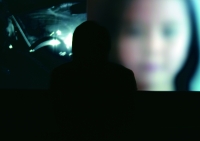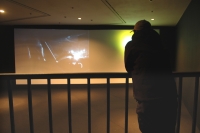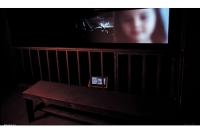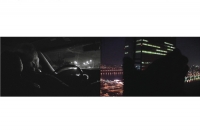잘못된 질문
9분 59초, 2채널 비디오설치, 2006
점차적으로 오르게 되어 있는 어두운 통로를 거쳐 발코니 공간에 다다르면 나란히 프로젝션 된 두 개의 화면을 바라보게 된다. 주차장이란 비장소 (non place)의 주차할 장소(place)를 찾아 맴도는 이미지로 시작하는 화면은 한국전쟁 이후 페허가 된 이 곳에서 어떻게 ‘먹고 살기 위해’ 박정희 전 대통령의 지휘 아래 단결하여 숨가쁘게 이 나라를 지켜왔는지 웅변하는 한 택시기사의 목소리를 듣게 된다. 그러나 화면의 이미지는 곧 작가 자신의 일상을 기록한 것으로 바뀌어가며 끊임없이 훈시하며 지배하는 택시기사의 독백 사운드로부터 거리를 유지하고 독립적으로 바뀌어나간다. 심지어 택시기사의 뒷모습을 바라보며 다른 꿈을 꾸고 있는 듯 몽상적 화면으로 펼쳐진다.
민주주의와 그 적을 구분해야 살아남았던 세대, 식민과 전쟁을 겪은 그 세대에게 이분법적 사고는 삶의 원동력이었고 개발과 성장 이데올로기에 의해 이 신화는 영원한 향수이며 끊임없이 조작되고 있다. ‘잘못된 질문’에서 반복되는 ‘한강의 기적’으로 불리는 이 신화는 피하지 않고 오히려 곱씹음으로써 극복하고자 하는 모순되고 어려운 길을 선택했다. 다시 말해서 잘못된 질문의 올바른 대답은 이미지와 소리의 부합이 아닌 오히려 그 서로의 거리 두기에 남겨져 있는 것에서 찾도록 한다. 인간의 광기는 바로 모호함을 용인하지 않고 언제나 자기편과 적을 간주해서 구분하는 데서 비롯하며 상상력은 바로 이미지와 소리의 간격으로부터 발생하는 또 다른 힘이기도 하기 때문이다.
삶은 어쩌면 그렇게 우연히 잡은 택시 안에서 선과 악을 가리는 것을 배우며 그래도 진실을 가려내야 하는 끝없는 선택의 연속선상에 놓인 여정을 떠난 것과 견줄 수 있을지도 모른다.
-
Wrong Question
9’ 59", 2 channel DVD projection, 2006
After walking through a dark, gradually ascending passageway, you will arrive in the balcony space where two projection screens are standing side by side. The video begins with a scene of driving around to find a ‘place’ to park in the ‘non-place’ of a parking area, accompanied by the voice-over of a taxi driver giving a harangue about how ardently his generation were united under the command of the former president Park Jeong Hee, in order to ‘keep alive’ and defend this country in the ruins of the Korean war. Then, the scene is followed by the images of the artist’s daily routine, whose narrative advances independently by increasing the distance from the driver’s monolog of constant scolding and nagging. This distance grows, until the camera presents some dreamlike scenes as if falling into its own dream, even while watching the driver’s back.
The generation who had to distinguish democracy from its opponent for the purpose of surviving, and who went through colonization and war, accepted binary thought as the dominating motive of their lives. The myth, or the timeless nostalgia, has been continuously manipulated by the ideology of development and growth. Wrong Question repeatedly questions about the very myth, or the so-called “Miracle of Han River.” And it is in a rather contradictory or difficult way that the film attempts to overcome the myth: do not avoid, but chew over it. Wrong Question intended to find the right answer to the wrong question not in the correspondence between image and sound, but in what is left behind in their distance. The human madness always comes from the tendency to draw a clear line between ‘us’ and ‘them’, intolerant of ambiguity, and out of the interval between image and sound springs another power, that is, imagination.
Probably, life might be a journey where you learn how to tell good from evil in a taxi you take casually and nevertheless, cannot be discharged from an obligation to stand in the endless line of choices about what is still true.



